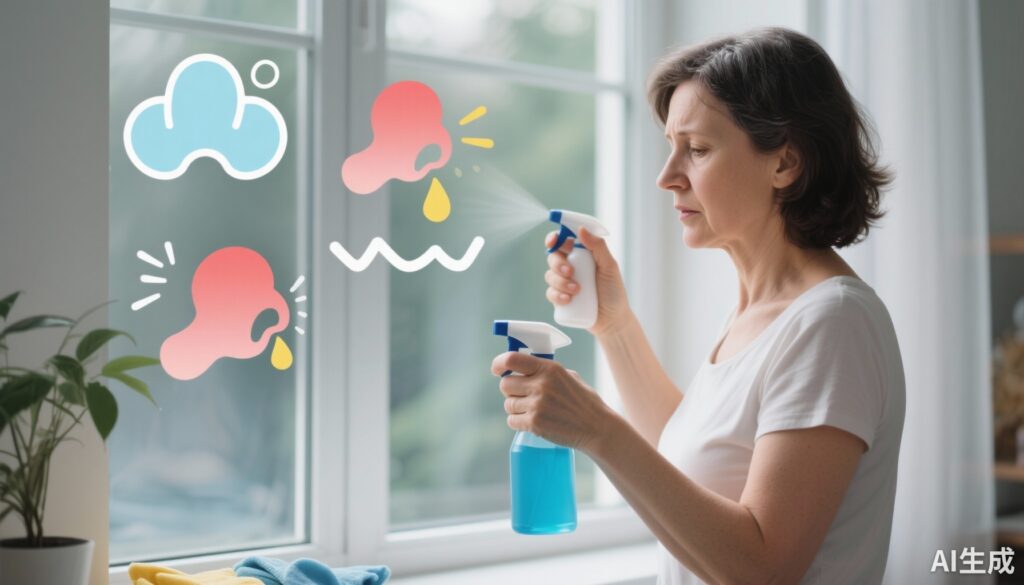Highlight
Recent longitudinal research from the NutriNet-Santé cohort highlights a noteworthy association between persistent weekly use of green cleaning products and a modest increase in asthma symptom risk. Specifically, persistent users demonstrated an 8% higher risk of asthma symptoms compared to nonusers, while increased weekly use carried a 7% higher risk. These findings parallel the more pronounced risks linked to conventional irritants and sprays.
Study Background
Asthma remains a prevalent chronic respiratory condition characterized by airway inflammation and hyperresponsiveness, affecting millions globally. Household cleaning products have long been recognized as environmental factors that may exacerbate respiratory symptoms and contribute to asthma pathogenesis through airway irritation and inflammation. Conventional cleaning sprays and irritants contain volatile organic compounds, fragrances, and other chemicals with established respiratory toxicity.
In recent years, “green” or environmentally friendly cleaning products have gained popularity, often perceived as safer alternatives due to their natural or plant-based components and limited use of harsh chemicals. However, evidence regarding their respiratory safety profile remains sparse and inconsistent, raising concerns about their potential to elicit or worsen asthma symptoms.
This study aimed to fill this evidence gap by investigating the longitudinal association between household use of green cleaning products compared with conventional irritants and the incidence or progression of asthma symptoms in a large adult cohort.
Study Design
This prospective observational study analyzed data from 30,012 adults enrolled in the French NutriNet-Santé cohort between 2018 and 2020. The participants had a mean age of 48.6 years, with female predominance (74.4%).
Data on respiratory health and household cleaning product use were collected using two standardized patient-administered questionnaires. Participants were classified based on asthma symptoms over the two-year interval as stable asymptomatic, stable symptomatic, improved, deteriorated, or incident cases.
Household cleaning product use was categorized weekly and differentiated into green cleaning products and conventional irritants/sprays. Usage patterns were further classified as no use, decreased use, persistent use, or increased use during the study period.
Primary endpoints included changes in asthma symptom scores and incidence of new asthma symptoms, quantified by mean score ratios (MSR) and adjusted odds ratios (aOR), respectively.
Key Findings
The baseline prevalence of persistent use was 40% for conventional irritants and sprays and 20% for green cleaning products; increased use was reported by 26% and 12% of participants, respectively.
Compared to no weekly use, participants with persistent green cleaning product use had a significantly increased asthma symptom score (MSR 1.08; 95% CI 1.01–1.16). Those who increased their green product use weekly also showed a trend towards higher symptom scores (MSR 1.07; 95% CI 0.99–1.16), though this did not reach conventional statistical significance.
In comparison, persistent use of conventional irritants/sprays was associated with a more robust increase in asthma symptom scores (MSR 1.26; 95% CI 1.18–1.34) and higher incidence of asthma symptoms (aOR 1.30; 95% CI 1.16–1.45).
Among participants with preexisting asthma symptoms, persistent and increased use of conventional irritants/sprays correlated with symptom deterioration (aOR 1.48; 95% CI 1.19–1.85 and aOR 1.28; 95% CI 1.01–1.64, respectively). These results were not reported for green cleaning products in this subgroup.
Expert Commentary
The study is a valuable addition to the understanding of environmental triggers for asthma, particularly in the context of the rising use of green cleaning products. While green products typically contain fewer synthetic chemicals and no harsh irritants, this research suggests that these products are not inherently free from respiratory risk. The reported 7-8% increased risk—though modest compared to conventional irritants—raises important questions about the safety assumptions associated with “green” household products.
Possible explanations include the presence of naturally derived volatile organic compounds or terpenes in green products that may contribute to airway irritation and inflammation. Additionally, fragrance components, even if plant-based, can induce respiratory hypersensitivity.
Limitations include reliance on self-reported questionnaire data, potential residual confounding, and lack of granular exposure metrics (e.g., specific product ingredients, frequency and duration of exposure). The predominance of middle-aged women might influence generalizability. Further mechanistic and experimental studies are needed to elucidate causal pathways and to characterize specific components driving respiratory effects.
Conclusion and Clinical Implications
This longitudinal study confirms that both conventional and green cleaning products may adversely impact asthma symptoms, with green cleaning products also associated with a modest but significant increased risk. These findings challenge the commonly held perception that green cleaning products are inherently safe for respiratory health.
Clinicians should incorporate advice about potential respiratory risks associated with all cleaning products during patient counseling, especially for individuals with asthma or heightened airway sensitivity. Minimizing exposure, ensuring adequate ventilation, and considering alternative cleaning approaches may mitigate symptom exacerbation.
Future research should aim to delineate safer product formulations and explore the biological mechanisms underpinning these observations to inform public health recommendations and product regulation.
Reference
Pacheco Da Silva E, Varraso R, Fezeu LK, Galan P, Hercberg S, Touvier M, Paris C, Le Moual N, Dumas O. Longitudinal associations between household use of “green” cleaning products and asthma symptoms. J Allergy Clin Immunol Pract. 2025 Sep 30:S2213-2198(25)00921-3. doi: 10.1016/j.jaip.2025.09.027. Epub ahead of print. PMID: 41038314.



